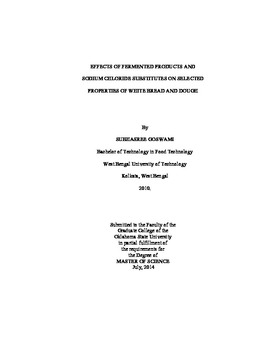| dc.contributor.advisor | Rayas-Duarte, Patricia | |
| dc.contributor.author | Goswami, Subhasree | |
| dc.date.accessioned | 2015-06-17T20:06:02Z | |
| dc.date.available | 2015-06-17T20:06:02Z | |
| dc.date.issued | 2014-07-01 | |
| dc.identifier.uri | https://hdl.handle.net/11244/14853 | |
| dc.description.abstract | Reducing sodium content in bread is a challenging proposition since sodium chloride contributes to more than saltiness perception in bread products. The objective of this study was to assess the effect of salt substitutes and fermented products (wheat-soybean tempe flour and sourdough) on flavor profile and rheological properties of bread. Tempe is an Indonesian traditional fermented food which is made by fungi fermentation of soybeans and other legumes.The desirable taste, flavor, texture, acidity and aroma are produced by the hydrolysis of substrates by enzymes. Sourdough process is very simple and is based on naturally occurring yeasts in the cereal grains. A commercial wheat flour with protein content 11 ± 0.5% was treated with sourdough (0, 11, 17 and 33% w/w) and tempe (0, 2, 3.5 and 5% w/w) and baked. Three sensory analysis sessions were conducted to determine the seven parameters flavor profile by 80 untrained panelists. This study showed that for saltiness score, the combination of 17% sourdough, 3.5%, panelists could not detect the difference in saltiness perception between 0.75 and 1.5% NaCl. One commercial wheat flour with protein content 11.8% was treated with different levels sodium chloride (0.75, 1.5 and 2.0%), wheat-soybean tempe flour (2 and 3.5%) and sourdough (17 and 33%) following a Randomized Complete Block Design with 3 replicates to analyze the rheological properties. Increase in development time, stability time and breakdown time was observed with elevation of NaCl levels. Development time and breakdown time decreased with increase in sourdough (17 vs 33%). A set of three commercial wheat flours with protein content 9.8, 10.9 and 13.4% was treated with sodium chloride (control) as well as five commercial NaCl substitutes following a Randomized Complete Block Design with 3 replicates to analyze the effect on rheological properties. Mixing properties showed that development time and stability time were directly proportional to the level of salt. Maximum resistance to extension (Rmax) and area under the curve increased with an increase of NaCl level. NaCl resulted in a higher area than commercial NaCl substitutes when each level of salt was analyzed. | |
| dc.format | application/pdf | |
| dc.language | en_US | |
| dc.publisher | Oklahoma State University | |
| dc.rights | Copyright is held by the author who has granted the Oklahoma State University Library the non-exclusive right to share this material in its institutional repository. Contact Digital Library Services at lib-dls@okstate.edu or 405-744-9161 for the permission policy on the use, reproduction or distribution of this material. | |
| dc.title | Effects of Fermented Products and Sodium Chloride Substitutes on Selected Properties of White Bread and Dough | |
| dc.type | text | |
| dc.contributor.committeeMember | Ramanathan, Ranjith | |
| dc.contributor.committeeMember | McGlynn, William | |
| osu.filename | Goswami_okstate_0664M_13629.pdf | |
| osu.accesstype | Open Access | |
| dc.description.department | Food Science | |
| dc.type.genre | Thesis | |
| dc.subject.keywords | bread | |
| dc.subject.keywords | cereal | |
| dc.subject.keywords | dough | |
| dc.subject.keywords | fermented products | |
| dc.subject.keywords | rheological properties | |
| dc.subject.keywords | sodium chloride substitutes | |
